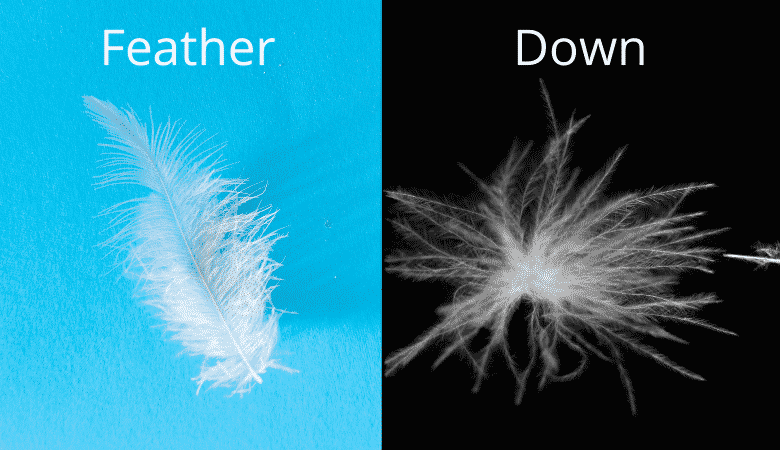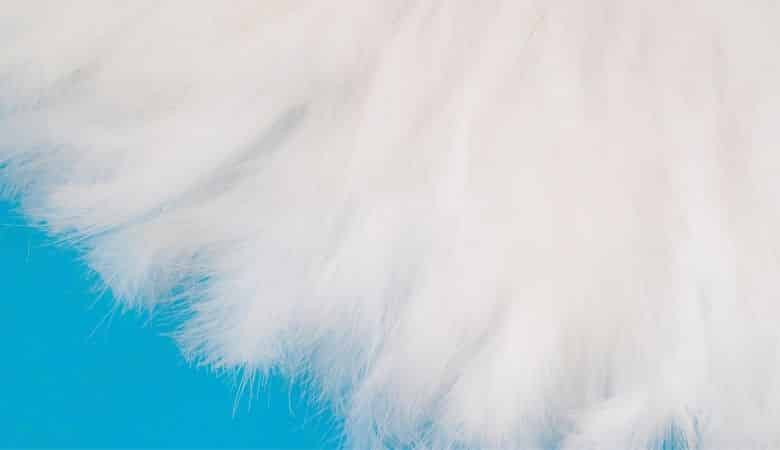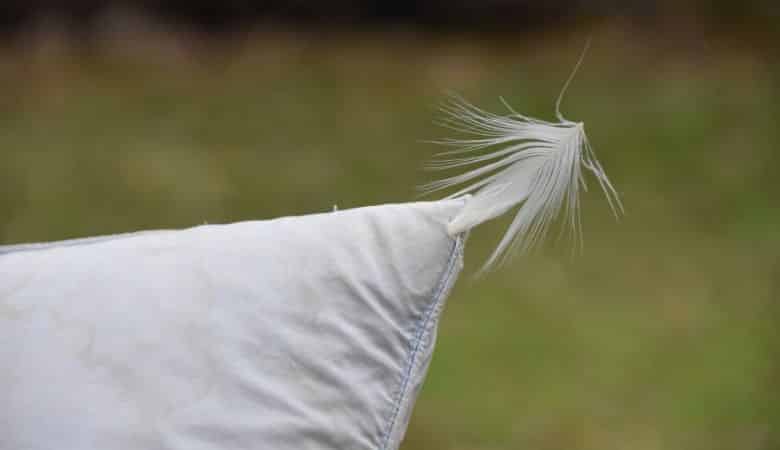This post is part of the complete feather pillow buyers guide
Over the last decade or so, the pillow and mattress industry has exploded to unbelievable levels. Maybe that’s because people realize the importance of good quality sleep, or they simply want to invest in quality and luxury.
Today, there is a massive selection of pillows ranging from memory foam, buckwheat, cotton, down, and even cooling pillows.
Interestingly, despite all the newcomers, people still prefer traditional options like down and feather pillows, and with good reason. These fiber pillows are moldable, durable, and super comfortable in every sleeping position.
Even after being around for so long, down and feather pillows are still a mark of luxury and comfort.
What are Feather Pillows?

Feather pillows are made from natural duck or goose feathers. The feathers are plucked from the wings or back of the bird, and they come as they are with the quill down the middle and everything. The heavier structure of feathers provides better support for your head and neck and longevity.
However, the quill can also stick out of the pillow shell and poke your skin while sleeping. For this reason, feather pillows are covered with a well-stitched, high-quality case that will keep the feathers from poking through. The cloth must be tight-weaved and secured at the seams with double stitching.
Are Feather Pillows the Same as Down Pillows?
Both down and feather pillows get their fillers from birds, or rather ducks and goose, but that’s about where the similarities end.
Feather pillows come from the wing and back feathers of the bird, and they have a flat structure and a quill in the middle. As you would expect, feathers make for a firm and incredibly supportive pillow, thanks to the quill.
Down pillows, on the other hand, come from the soft fibers that make the birds undercoat, specifically the chest area of the duck or goose. Down has a fluffier appearance, made of centralized points from which the soft fibers spread out. The best way to describe down fibers is to say they look a lot like tiny cotton wool pieces.

That said, all feather pillows have a percentage of down, usually 5-10%, to provide additional softness. Without the down fibers, your feather pillow would be too firm and hard for comfort.
Want to read more about the difference between feather and down pillows? Check out this post.
Advantages of Feather Pillows
1. Durability
Feather-filled pillows typically last longer than synthetic ones and can wear well up to ten years or more. Manufacturers say a good quality feather pillow has at least a 25% greater lifespan than regular pillows. However, this depends on how well you take care of the pillow.
2. Exceptional support
There are two main reasons why you buy a pillow- support and comfort. Feather pillows are soft enough for comfort and firm enough to provide support. Like memory foam pillows, they will conform to the shape of your neck and head and cradle you up nicely.
In addition, the pillow has medium to firm support, and it’s very friendly for back and side sleepers because it has a generous loft. If you are somebody who changes sleeping positions throughout the night, feather pillows are perfect for you because they easily conform to your new position’s shape.
3. Better Temperature Control

One of the reasons people are willing to invest in higher quality pillows is breathability and temperature control. With most pillows, you will notice the zone where your head rests is warm. If you decide to turn and move your head, your face lands on an icy area, jolting you out of sleep immediately.
Even worse than being woken up by a cold pillow is waking up sweating because the pillow got too hot. These are not problems you will deal with when you buy a feather-filled pillow. They have superb insulation, so they will neither get too hot or cold during the night. Feathers are designed to protect birds from extreme weather naturally, so they remain near the ambient temperature at all times.
4. Ease of care
Taking care of feather-filled pillows is easy because most of them can be machine washed and dried. Ideally, you should tumble dry the pillow once every six months just to kill germs and get rid of any dust. The pillow cover will ensure your pillows remains clean throughout the year, so you don’t need to wash the pillow as often.
5. Lightweight
As light as a feather is an English simile that describes this situation perfectly. Feather pillows are incredibly lightweight and perfect for travel.
6. Hypoallergenic

In its natural form, a feather pillow can be allergy-causing because of animal dander and other factors. However, reputable pillow manufacturers clean and remove all dander and microbes from the feathers before putting them inside the pillow.
In fact, the feathers go through rigid sterilization to remove all allergens and leave the pillows completely allergy-free. It’s also important to note that feathers are anti-allergenic, meaning they don’t attract bacteria, fungi, or dust mites.
7. Soft and comfortable
They are incredibly soft and comfortable.
8. Malleability
Feather pillows are very easy to manipulate and can be contrived in various fashions for maximum comfort. They can also be easily molded or adjusted for added support.
9. Affordability
Last but not least, feather pillows are far more affordable than their down, latex, or memory foam counterparts. A high-quality feather-filled pillow will cost between $25 to $50, depending on the amount of down inside the pillow and of course the quality of the pillows cover.

Disadvantages of Feather Pillows
1. Cleaning can be complicated
While most feather-filled are machine-washable, the process of doing that is that easy. For example, drying too hot can scorch the feathers and ruin the pillow.
Leaving the pillow with even a tiny bit of moisture can also wreak havoc on your pillow by allowing mold inside.
As if that wasn’t bad enough, washing and drying can cause clumping of the feathers and down clusters, making your pillow lumpy and flat.
2. Feather fillings don’t grow on trees

As you may know by now, feathers come from ducks, goose, and other birds. Whether the feathers are plucked from a live bird or a dead one, the process is still inhumane to some extent.
People concerned about animal welfare will probably not recommend buying feather or down-filled pillows because their production harms different birds.
3. Feather pillows flatten in your sleep
You may have heard about the exceptional support that comes with feather pillows and how they conform and cradle your head to perfection.
What most users forget to tell you is that the support you feel will be short-lived. Feather pillows tend to flatten under the weight of your head through the night, and eventually your head will go down and cause your neck to bend. The only way out of this is to wake up and re-fluff the pillow at night, so it goes back to its supportive nature.
That said, some companies put a different filling at the bottom of the pillow to act as support for when the feathers give in to your weight.
4. New pillows have an odor
Here is the downside to sterilizing and cleaning the feathers- chemical odor. Some people complain that new feather pillows smell like chemicals because of the cleaning. However, this smell will go away with time, or you will get used to it.
5. Pillow piercing
As noted above, you may come across a low-quality feather pillow that allows feather quills to poke through the pillowcase. That’s why it’s important only to buy high-quality pillows made with tough, double-stitched material.

Who is Best Suited for Feather Pillows?
- Back and side sleepers, although low-loft pillows may be a problem for people who weigh more than 130 pounds.
- People who sleep hot since feather pillows do not retain body heat and usually sleep cool.
- People who like to cuddle with a pillow while they sleep, because the pillows are moldable.
However, feather pillows are not suitable for:
- Stomach sleepers. These people tent to sink too deeply into low-loft pillows. Unfortunately, high-loft pillows may cause spinal misalignment.
- People who awake easily because of noise, since feather pillows have been accused of being somewhat noisy.
- If you are sensitive to smell. Some feather pillow owners report persistent chemical smells.
- People with neck, shoulder, and back pain because feather pillows tend to flatten out and lose support later in the night.
Taking Care of Feather Pillows
One of the best qualities of feather pillows is durability. They can last more than ten years if well taken care of. So, how do you make sure they last that long and stay in good condition?
- Avoid moisture. The cardinal rule when it comes to feather-filled pillows is NO WATER. This doesn’t just apply to washing the pillow, though. You must also avoid going to bed with wet or oily hair that can put some dampness on the pillows. If you must wash hair before bed, ensure you dry it completely because any slight wetness can impact the durability of your pillow.
- Follow proper care instructions. All pillows will come with instructions on how to clean, store and use them. One of those instructions is how to wash the pillow. Luckily, most of them can be machine washed, and also machine dried. The important thing here is to be particular about the recommended temperature settings. Make sure the pillow is completely dried using a slow and warm drier.
- Always cover your pillow. The only way to avoid washing your pillow regularly is to cover it with a pillowcase. This will protect it from dust, oils, stains, and all manner of things that can ruin the pillow. When buying the pillowcase, make sure it’s soft and hypoallergenic so it doesn’t cause you any discomfort. The case should also be thick enough to prevent moisture and oils from your body from sipping through to the pillow.
- Treat them gently. Unfortunately, feather pillows are not the best option for pillow fights and mishandling. Compressing them during storage or using them to fight will break down the material and ruin the pillow.
What to Think About When Buying a Feather Pillow

Feather pillows are comfortable, supportive, hypoallergenic, and very pocket-friendly. If you decide to spoil yourself with one or two, consider these tips for buying the best feather-filled pillow.
Loft
Loft is simply the thickness of a pillow. Choosing a high loft pillow is always ideal, but you should consider your sleeping position.
People who sleep on their side and back sleepers will benefit from high loft because it puts the head, neck, and shoulders in alignment. However, stomach sleepers need extremely low loft to keep the entire body in alignment.
Support
Unfortunately, feather pillows do not provide support throughout the night because they tend to flatten out. Instead, choose a pillow that has another filling like memory foam at the bottom. Ideally, this other material should take 20% of the filling space to give you optimum support.
The Ticking
When a pillow has feather filling, the ticking is very important. Make sure it has a well-stitched, high-quality casing to keep the feathers from poking through. Ideally, the case should have a tight-weave and secure double-stitched seams.
When buying at the shop, look for pillows whose casing has a 250 thread count or higher. This refers to how strong, tough, and thick the material is to keep the feathers securely inside.
Feather and Down Mixture
To combat the few disadvantages of feather-filled pillows, some manufacturers put equal measures of feather and down fillings in the pillow.
The down and feather mixture results in a bulkier, more supportive, and luxuriously soft pillow. Down brings the softness and warmth plus prevents the pillow from flattening. Feathers, on the other hand, bring durability and wick away heat and moisture for a cool and comfortable sleep.
Summary
It’s clear that the pros and cons of feather pillows depend on the design, toughness of the outer shell, and composition of the filling. But, when picked wisely, feather pillows can be the epitome of comfort and luxury, plus they feel like a love-filled hug.
To maintain the loft and support through the night, always fluff the pillow before you sleep. Hyper-sensitive sleepers can add an allergen-impermeable cover to add a layer of defense against the allergens that may live inside the pillow.
Feather Pillows: A complete buyers guide – Parts:
1. Why Should You Use A Feather Pillow? The pros and cons
2. Down vs. Feather Pillows: What’s the difference and which is better?
3. How Long Do Feather Pillows Last? This is the replacement time
4. How to Wash And Dry a Feather Pillow: Step by step guide
5. How to Stop Your Feather Pillow From Leaking Feathers
6. Best Feather Pillows of 2021 – Full Guide and Review



